Interventions used in control group against cupping therapy for chronic nonspecific low back pain: A systematic review and network meta-analysis
IF 3.5
3区 医学
Q1 INTEGRATIVE & COMPLEMENTARY MEDICINE
引用次数: 0
Abstract
Introduction
The evidence for the effect of cupping therapy on chronic nonspecific low back pain (CLBP) remains controversial, and existing researches didn’t consider outcomes influenced by factor of selection of interventions in control group. This review and network meta-analysis is to compare the effects of diverse interventions in cupping therapy control groups for CLBP, with the objective of identifying the suitable control intervention against cupping therapy for CLBP.
Methods
Studies were identified by a comprehensive search of databases, such as PubMed, Embase, Cochrane Library, Web of Science and China National Knowledge Infrastructure (CNKI), up to June, 2024. A total of 10 randomized control trials (RCT) were included in this network meta-analysis (NMA).
Results
The results showed that compared with cupping therapy, minimum negative pressure cupping therapy (MNPCT) (SMD = − 0.01; 95 %CI: − 0.92 to 0.89), air circulating cupping therapy (ACCT) (SMD = − 0.05; 95 %CI: − 0.63 to 0.54) and diclofenac (SMD = − 0.13; 95 %CI: − 1.13 to − 0.87) was no significantly different from improvement of pain intensity. But there was significant difference between cupping therapy and D-ibuprofen (SMD = − 1.11; 95 %CI: − 2.08 to − 0.13), paracetamol (SMD = − 1.12; 95 %CI: − 1.80 to − 0.43) or usual care (SMD = − 1.18; 95 %CI: − 2.56 to − 1.06). The order of intervention effect by SUCRA diagram was as follows: cupping therapy (77.7 %) > MNPCT (75.2 %) > ACCT (73.8 %) > diclofenac (68.8 %) > D-ibuprofen (26.3 %) > paracetamol (24.5 %) > usual care (3.8 %). The quality of evidence for network estimates was moderate to very low due to the risk of bias and imprecision.
Conclusions
The results of this study suggest that usual care was the least effective in alleviating the pain intensity of CLBP, which might serve as the most appropriate intervention in the control group in cupping-related RCTs. MNPCT and ACCT have similar effects with cupping therapy for CLBP. Future research may be based on some objective clinical outcomes and control interventions with physiological inertia to isolate the true effect of cupping therapy or SCT from psychological biases.
Trial registration
The protocol was registered on the international prospective register of systematic reviews (http://www.crd.york.ac.uk/PROSPERO), registration number: CRD42024527513.
对照组对慢性非特异性腰痛拔罐治疗的干预措施:系统综述和网络荟萃分析。
导论:火罐治疗慢性非特异性腰痛(CLBP)的疗效证据尚存争议,现有研究未考虑对照组干预措施选择因素对结果的影响。本综述和网络荟萃分析旨在比较不同干预措施在火罐治疗CLBP对照组中的效果,以确定适合的火罐治疗CLBP的对照干预措施。方法:综合检索PubMed、Embase、Cochrane Library、Web of Science、中国知网(CNKI)等数据库,检索时间截止到2024年6月。本网络荟萃分析(NMA)共纳入10项随机对照试验(RCT)。结果:与拔火罐疗法相比,最小负压拔火罐疗法(MNPCT) (SMD = -0.01;95%CI: -0.92 ~ 0.89),空气循环拔罐疗法(ACCT) (SMD = -0.05;95%CI: -0.63 ~ 0.54)和双氯芬酸(SMD = -0.13;95%CI: -1.13 ~ -0.87)与疼痛强度的改善无显著差异。拔火罐治疗与d -布洛芬治疗差异有统计学意义(SMD = -1.11;95%CI: -2.08 ~ -0.13),扑热息痛(SMD = -1.12;95%CI: -1.80至-0.43)或常规护理(SMD = -1.18;95%CI: -2.56 ~ -1.06)。SUCRA图干预效果排序为:拔罐治疗(77.7%)> MNPCT (75.2%) > ACCT(73.8%) >双氯芬酸(68.8%)> d -布洛芬(26.3%)>扑热息痛(24.5%)>常规护理(3.8%)。由于存在偏倚和不精确的风险,网络估计的证据质量从中等到非常低。结论:本研究结果提示,常规护理在缓解CLBP疼痛强度方面效果最差,在拔火罐相关随机对照试验中,常规护理可能是对照组最合适的干预措施。MNPCT和ACCT治疗CLBP与火罐治疗效果相似。未来的研究可能会基于一些客观的临床结果和具有生理惯性的对照干预措施,将拔火罐疗法或SCT的真实效果与心理偏差分离开来。试验注册:该方案已在国际前瞻性系统评价注册库(http://www.crd.york.ac.uk/PROSPERO)上注册,注册号:CRD42024527513。
本文章由计算机程序翻译,如有差异,请以英文原文为准。
求助全文
约1分钟内获得全文
求助全文
来源期刊

Complementary therapies in medicine
医学-全科医学与补充医学
CiteScore
8.60
自引率
2.80%
发文量
101
审稿时长
112 days
期刊介绍:
Complementary Therapies in Medicine is an international, peer-reviewed journal that has considerable appeal to anyone who seeks objective and critical information on complementary therapies or who wishes to deepen their understanding of these approaches. It will be of particular interest to healthcare practitioners including family practitioners, complementary therapists, nurses, and physiotherapists; to academics including social scientists and CAM researchers; to healthcare managers; and to patients. Complementary Therapies in Medicine aims to publish valid, relevant and rigorous research and serious discussion articles with the main purpose of improving healthcare.
 求助内容:
求助内容: 应助结果提醒方式:
应助结果提醒方式:


